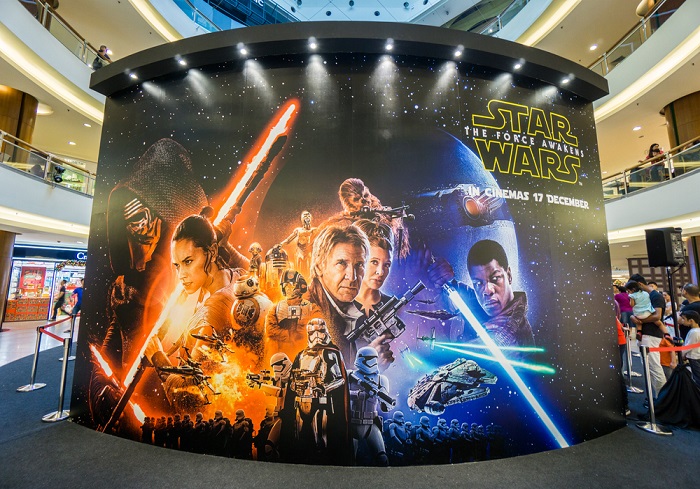
After nearly a decade of waiting (or three for diehards that don’t count the prequels), fans are flocking to theaters to watch a new Star Wars movie. With millions of tickets sold months in advance for “The Force Awakens’” opening weekend, it’s a fair bet to say that the movie has capitalized on the cultural cache its predecessor films created.
However, even if “The Force Awakens” turns out to be everything fans want and more, does that still give Disney a pass for its borderline obsessive initiative to brand everything and the kitchen sink with the Star Wars tag?
Many were skeptical when Disney announced that it had purchased Lucasfilm — and the rights to the Star Wars franchise with it — in 2012, but so far, its decisions on the creative side of the filming process seem reasonable enough. However, consumers have begun to take to social media to lampoon what they see as comical overreaches in branding — like sticking a picture of Jedi master Yoda on a package of seedless green grapes.
Mental Floss explained that the Sage Fruit Company also offers Darth Vader and his iconic red lightsaber on a bag of red delicious apples, along with accompanying Stormtroopers on the reverse. Not to be outdone, Coffee-Mate slapped images of R2-D2, C-3PO, Chewbacca and bounty hunter Boba Fett on its coffee creamer products, but it didn’t stop until partnering with three popular YouTube streamers to get the word out, Tubefilter reported.
There are, of course, a seemingly infinite number of combinations Disney can make with products that consumers need and those not already tagged with the Star Wars logo: clothing, accessories, computer gadgets, USB chargers, phone cases, kitchen appliances, ice cube trays, app-controlled droids. To carpet-bomb the market before the movie even comes out requires either stupendous confidence from Disney that fans are ready and eager for more Star Wars content in their lives after so long without or perhaps is just what happens when a company with a history of rapid merchandising takes on a film franchise that practically invented the pop culture phenomenon of the blockbuster.
Io9 has a breakdown of how the release of “A New Hope” in 1977 convinced not only movie executives but toy designers that consumers are willing to buy branded products as a way of continuing their interactions with the movies in between installments of the first trilogy. Without fast turnarounds for home video release or even the Internet to talk with other enthusiasts, fans only had the ever-increasing supply of action figures, LEGO sets and more toys being put out by Kenner, the original Star Wars toy producer. In addition to giving birth to the modern action figure collectors’ subculture, it also opened marketing executives’ eyes to the potential of cash windfalls with each film in the franchise.
Fast forward to 2015, and it’s no longer Kenner but the Disney conglomerate that holds the means of Star Wars-branded toy production. However, as the media giant has proven, it’s willing to go far beyond the realm of action figures and children’s trinkets, and David Soberman, professor of marketing at the University of Toronto, told Global News that no one should be surprised at the result.
“You have to ask, when you see a merger: Are there complementary things these companies can share with each other?” Soberman said. “The thing with Lucasfilm is it owned Star Wars. That was its main thing. People love it; everyone knows about it. There can’t be anyone better suited to merchandising of any kind — cups, games, robots, makeup, clothing, almost anything — than Disney. It’s the most experienced company in terms of licensing brands and making money from it. Putting Disney and Lucasfilm together created a huge amount of value.”
How much value? MarketWatch quotes Macquarie Research Analyst Tim Nollen at a figure of $5 billion in the first year of merchandising alone. Jeffrey Logsdon of JBL Advisors pegs the branding push at anywhere between $2.08 billion and $3.33 billion by 2017, which doesn’t take into account the box office revenue that’s sure to be the size of a small starship.
Given the resources to achieve it, it’s hard not to imagine studios like Marvel and DC doing the same kind of merchandising blitz with their tentpole superhero releases. However, Philip Ryan, director of brand strategy consulting firm Vivaldi Partners Group, told MarketWatch that an endless supply of merchandising will start to rub consumers the wrong way, no matter how beloved a franchise it draws from.
“The movies still drive the mystique,” Ryan said. “However, over time, all of that merchandising starts to gnaw away at the movies, and if every single one of them is not phenomenal, then some of that over-merchandising starts chipping away at the brand.”
Disney has taken a complex, calculated choice with its marketing campaign for “The Force Awakens.” If the movie turns out to be a dud, the glut of branded products will almost certainly be reviled by consumers. So far, all signs point to the opposite, and much like the Jedi’s desire for balance in the Force, if the new Star Wars movie can strike it rich with fans, Disney will only have more enthusiasm to rely on for its next line of Vader-endorsed pomegranates.